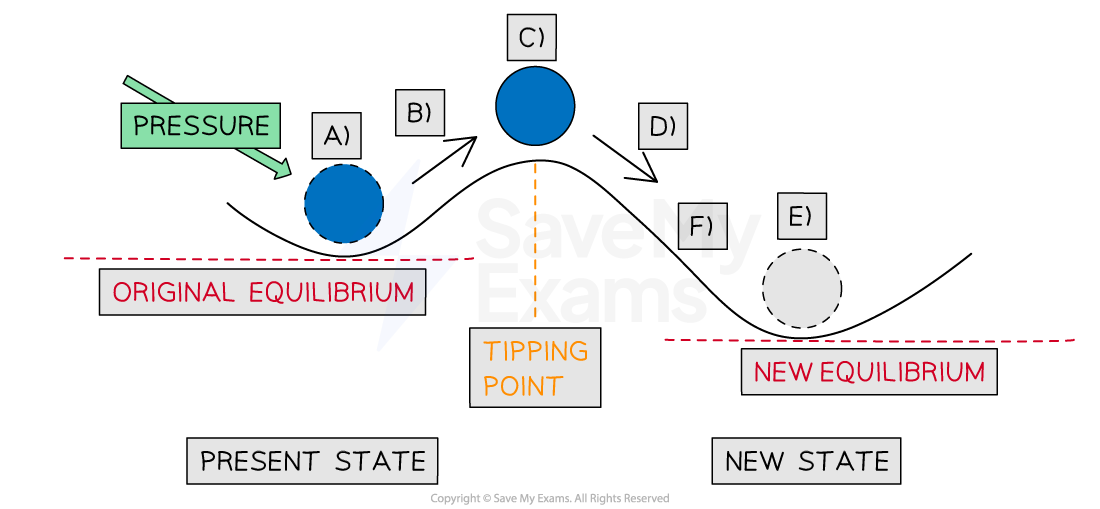Tipping Points
- A tipping point is a critical threshold within a system
- If a tipping point is reached, any further small change in the system will have significant knock-on effects and cause the system to move away from its average state (away from the equilibrium)
- In ecosystems and other ecological systems, tipping points are very important as they represent the point beyond which serious, irreversible damage and change to the system can occur
- Positive feedback loops can push an ecological system towards and past its tipping point, at which point a new equilibrium is likely to be reached
- Eutrophication is a classic example of an ecological reaching a tipping point and accelerating towards a new state
- Tipping points can be difficult to predict for the following reasons:
- There are often delays of varying lengths involved in feedback loops, which add to the complexity of modelling systems
- Not all components or processes within a system will change abruptly at the same time
- It may be impossible to identify a tipping point until after it has been passed
- Activities in one part of the globe may lead to a system reaching a tipping point elsewhere on the planet (e.g. the burning of fossil fuels by industrialised countries is leading to global warming, which is pushing the Amazon basin towards a tipping point of desertification) - continued monitoring, research and scientific communication is required to identity these links

(A) The system is subject to a pressure that pushes it towards a tipping point. (B) The system’s tipping point (critical threshold) is reached. Like a ball balancing on a hill, at this stage even a minor push is enough to cross the tipping point, upon which positive feedback loops accelerate the shift (D) into a new state (E). The change to the new state is often irreversible or a high cost is required to return the system back to its previous state, which is illustrated in the figure as a ball being in a deep valley (E) with a long uphill climb back to the previous state (F)
Worked example
Evaluate the possible consequences of environmental tipping points, using the melting of polar ice caps and glaciers as an example.
Answer
The consequences of environmental tipping points can be severe and long-lasting, with effects that extend beyond the immediate environment. One such example is the melting of polar ice caps and glaciers, which can have the following consequences:
Rising Sea Levels:
As polar ice caps and glaciers melt, the water they release adds to the volume of the ocean. This can lead to rising sea levels, which can inundate low-lying areas and cause flooding, erosion, and damage to infrastructure.
Changes in Ocean Currents:
The melting of polar ice caps and glaciers can alter the salinity and temperature of the ocean, which can affect ocean currents. Changes in ocean currents can impact global weather patterns and have cascading effects on ecosystems.
Loss of Biodiversity:
Polar regions are home to a diverse range of species, many of which are adapted to the extreme conditions found there. The loss of polar ice caps and glaciers can lead to the loss of habitat and food sources, leading to declines in biodiversity.
Release of Greenhouse Gases:
Melting permafrost, which is soil that has been frozen for long periods, can release large amounts of methane and carbon dioxide, which are both potent greenhouse gases. This can contribute to climate change and lead to further melting of polar ice caps and glaciers.
Changes in Global Temperatures:
The melting of polar ice caps and glaciers can change the reflective properties of the Earth's surface. This can result in more sunlight being absorbed, leading to an increase in global temperatures and further melting of ice.
- The melting of polar ice caps and glaciers is just one example of the many ways in which human activities can push the Earth's systems beyond their limits and towards environmental tipping points
- It is important for individuals and governments to take action to reduce greenhouse gas emissions and protect the planet's natural systems


